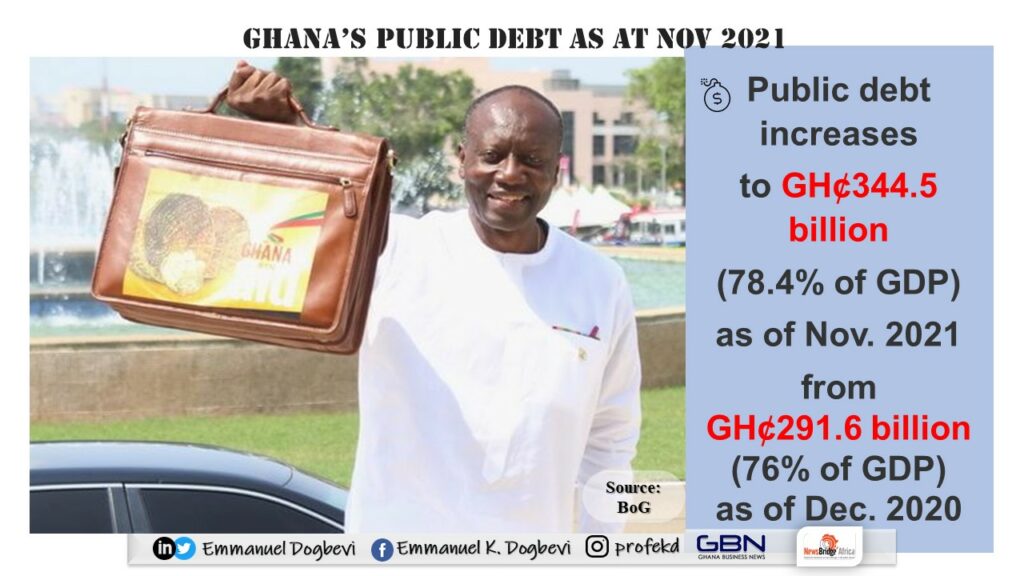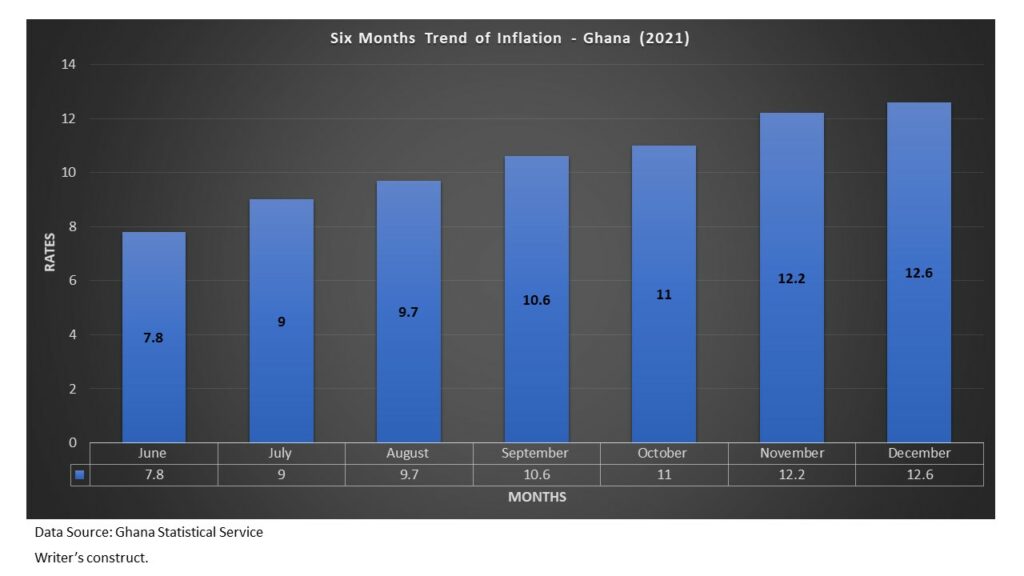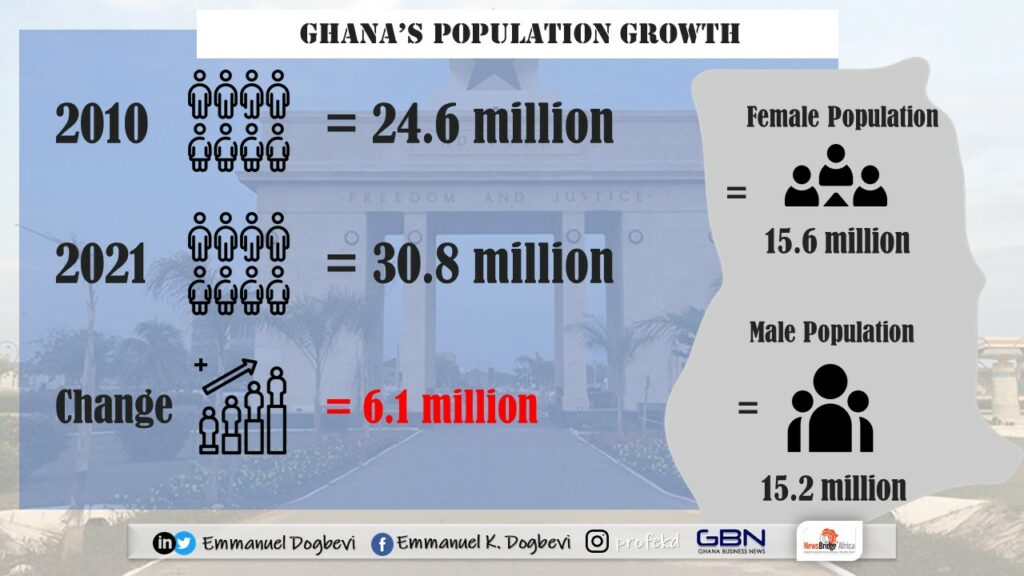The state of Ghana in numbers
 There are instances where numbers speak with some clarity that words may not. There are numbers that clearly define and reflect the real state of affairs of Ghana, numbers that show where the country is and where it is heading. Some of the numbers speak to how bad things are, others show the danger ahead, how good things look, and the rest gives us food for thought.
There are instances where numbers speak with some clarity that words may not. There are numbers that clearly define and reflect the real state of affairs of Ghana, numbers that show where the country is and where it is heading. Some of the numbers speak to how bad things are, others show the danger ahead, how good things look, and the rest gives us food for thought.
The population
From the recently conducted 2021 Population and Housing Census by the Ghana Statistical Service (GSS), Ghana’s population has increased by 6.1 million from the last population figures of 2010, which was 24.6 million to 30.8 million.
According to the GSS, the increase in population was driven by three processes – fertility, mortality and migration. Projecting on this rate, Ghana‘s population would double within 33 years and by 2050, it would be over 50 million.
Among the population, 15.6 million are females, representing 50.7 per cent and 15.2 million are males, representing 49.3 per cent, giving a national sex ratio of 97 males for every 100 females.
Public debt
 Ghana is at high risk of debt distress. That means the country is unable to fulfil its financial obligations – in other words, the country can’t pay its debts.
Ghana is at high risk of debt distress. That means the country is unable to fulfil its financial obligations – in other words, the country can’t pay its debts.
Between 2010 and 2017, the country’s public debt rose close to 145 per cent, from GH¢57 billion to GH¢139.5 (calculated at today’s exchange rate of GH¢6.34 to $1.)
Currently, the Bank of Ghana has indicated that the public debt has increased to GH¢344.5 billion, which is 78.4 per cent of GDP at the end of November 2021, compared with GH¢291.6 billion, or 76.0 percent of GDP at the end of December 2020.
The domestic debt was GH¢179.4 billion (40.8 percent of GDP), while the external debt was GH¢165.1 billion (37.6 percent of GDP).
As a result of the debt situation, two weeks ago, the rating agency, Fitch downgraded Ghana to B Negative with Negative Outlook. The agency downgraded Ghana’s Long-Term Foreign Currency Issuer Default Rating (IDR) to B Negative from B, and the Outlook is Negative.
According to Fitch, the downgrade of Ghana’s IDRs and Negative Outlook reflect the country’s or sovereign’s loss of access to international capital markets in the second half of 2021, following a pandemic-related surge in government debt, noting that this comes in the context of uncertainty about the government’s ability to stabilise debt and against a backdrop of tightening global financing conditions.
Gross International Reserves and policy rate
The Bank of Ghana, states that the country’s Gross International Reserves as at December 2021 stood at $9.7 billion (equivalent to 4.4 months of import cover). This compares with a reserve position of $8.6 billion (4.0 months of import cover) at the end of 2020. Gross Reserves have since increased to $9.9 billion as at January 28, 2022, and the central bank has maintained the policy rate at 14.5 per cent. The policy rate is the baseline rate at which the commercial banks lend money to customers.
GDP growth
The Bank of Ghana citing the Ghana Statistical Service update, reports that Real GDP growth for the first three quarters of 2021 averaged 5.3 per cent, compared with an average contraction of 0.6 per cent recorded in the same period of 2020. It added that non-oil GDP growth averaged 6.9 per cent against a contraction of 0.3 per cent over the same comparative period. It then projects overall GDP growth for 2021 to exceed the target of 4.4 per cent.
Inflation figures
 Inflation in Ghana has been on the upward trend in the last six months of 2021. The GSS announced 7.8 per cent for the month of June; in July inflation went up to 9.0 per cent, then rises to 9.7 per cent in August and rose to 10.6 per cent in September. In October, it rose 0.4 per cent to 11 per cent and rose again to 12.2 per cent in November and the December figure stood at 12. 6 per cent – largely driven by fuel and food prices.
Inflation in Ghana has been on the upward trend in the last six months of 2021. The GSS announced 7.8 per cent for the month of June; in July inflation went up to 9.0 per cent, then rises to 9.7 per cent in August and rose to 10.6 per cent in September. In October, it rose 0.4 per cent to 11 per cent and rose again to 12.2 per cent in November and the December figure stood at 12. 6 per cent – largely driven by fuel and food prices.
Unemployment numbers
 Ghana’s unemployment numbers have almost tripled in less than 10 years, according to the latest Population and Housing Census. It indicates that more than 1.5 million people, or 13.4 per cent of citizens able to work, can’t find jobs.
Ghana’s unemployment numbers have almost tripled in less than 10 years, according to the latest Population and Housing Census. It indicates that more than 1.5 million people, or 13.4 per cent of citizens able to work, can’t find jobs.
A World Bank Report on the state of Ghana’s economy, indicated that even though the economy is expanding, it’s unable to create high paying jobs which require highly specialised skills, especially in the innovation sector.
Housing challenges
 Ghana has a housing crisis. The high cost of construction and unavailability of housing, coupled with growing population have put access to decent housing out of the reach of many disadvantaged Ghanaians.
Ghana has a housing crisis. The high cost of construction and unavailability of housing, coupled with growing population have put access to decent housing out of the reach of many disadvantaged Ghanaians.
Ghana reportedly has a housing deficit of two million, and the 2021 Population and Housing Census noted that 60 per cent of the working population needs help to access housing, while 35 per cent will not be in a position to access housing even with government subsidy. The proportion of Ghana’s population that lives in slums is 40 per cent, and 20 per cent of the population lives in kiosks.
Number of Parliamentarians and Ministers of State
Ghana’s population of 30.8 million people are represented in Parliament by 275 MPs from the ruling New Patriotic Party and opposition National Democratic Congress with one Independent candidate.
As numbers tell direct and unambiguous stories, these numbers lay bare the reality that is the country Ghana. While the numbers tell us what we must know, they also tell us what we must do to attain a desired future.
By Emmanuel K. Dogbevi
Copyright ©2022 by NewsBridge Africa
All rights reserved. This article or any portion thereof may not be reproduced or used in any manner whatsoever without the express written permission of the publisher except for the use of brief quotations in reviews.

